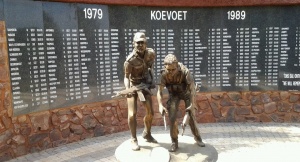Difference between revisions of "Koevoet"
m (Text replacement - "|leader=" to "|leaders=") |
(Added: leader.) |
||
| Line 8: | Line 8: | ||
|leaders=Colonel | |leaders=Colonel | ||
|num_staff=1000 | |num_staff=1000 | ||
| + | |leader=Colonel | ||
}} | }} | ||
Apartheid-era South African counter-insurgency unit in Namibia. | Apartheid-era South African counter-insurgency unit in Namibia. | ||
Revision as of 13:28, 16 April 2016
 Koevoet memorial wall (1979-1989) | |
| Successor | Special Field Force |
| Headquarters | Oshakati, Oshana Region |
| Leader | Colonel |
| Type | Paramilitary |
| Staff | 1,000 |
Apartheid-era South African counter-insurgency unit in Namibia.
- The Koevoet ("crow-bar") units were formed in the late 1970s in Namibia by the occupying apartheid South African authorities to track down and eliminate SWAPO guerrillas, who crossed the border from bases in Angola. The units, made up of black Namibians commanded by whites from the South-West African police (SWAPOL), operated from armoured cars with heavy weapons.
- Koevoet drew complaints for using tough interrogation methods on civilians to learn the whereabouts of SWAPO guerrillas. Because of the outcry, the Koevoet troopers were ostensibly reassigned earlier this year [1989] to conventional police duties, but in fact their units remained intact.[1]
In October 1989, under orders of the UN Security Council, Pretoria was forced to demobilise some 1,600 members of the Koevoet counter-insurgency force. The Koevoet issue had been one of the most difficult UNTAG faced. The unit was formed by South Africa after the adoption in 1978 of UNSCR 435, and was not, therefore, mentioned in the Settlement Proposal or related documents.
The UN regarded Koevoet as a paramilitary organisation which ought to be disbanded but the unit continued to deploy in the north in armoured and heavily armed convoys. In June 1989 Martti Ahtisaari, the UN Special Representative told Administrator-General, Louis Pienaar, that this behaviour was totally inconsistent with the Settlement Proposal, which required the police to be lightly armed. Moreover, the vast majority of the Koevoet personnel were quite unsuited for continued employment in the SWAPOL. The Security Council, in its resolution 640 (1989) of 29 August, therefore demanded the disbanding of Koevoet and dismantling of its command structures.
South African foreign minister, Pik Botha, announced on 28 September 1989 that 1,200 ex-Koevoet members would be demobilised with effect from the following day. A further 400 such personnel were demobilised on 30 October. These demobilisations were supervised by UNTAG military monitors.[2]
References
- ↑ "South Africa Disbands Special Police in Namibia", by Christopher S. Wren, New York Times, 1 October 1989.
- ↑ "Pretoria Spent $35 Million to Influence Namibian Vote" Christopher Wren, 26 July 1991, New York Times